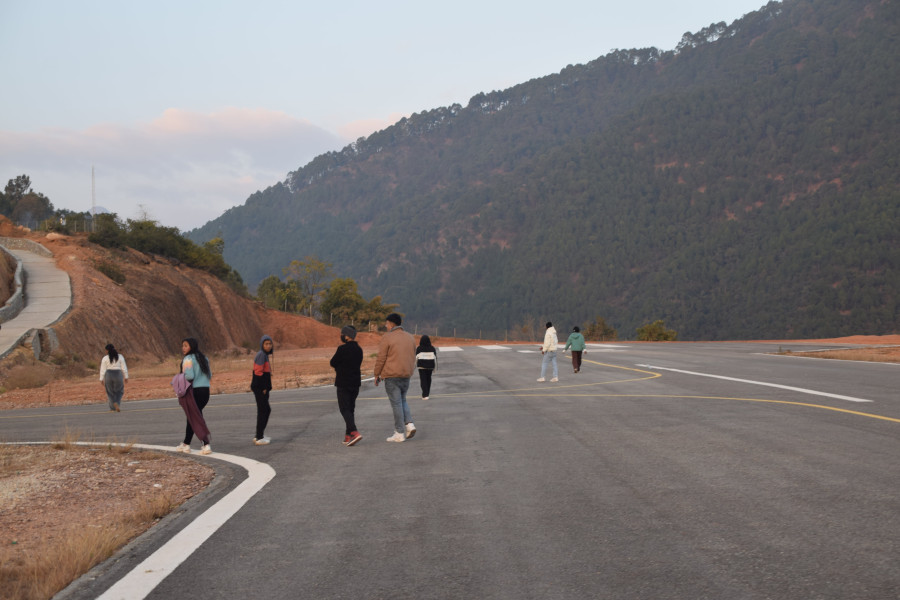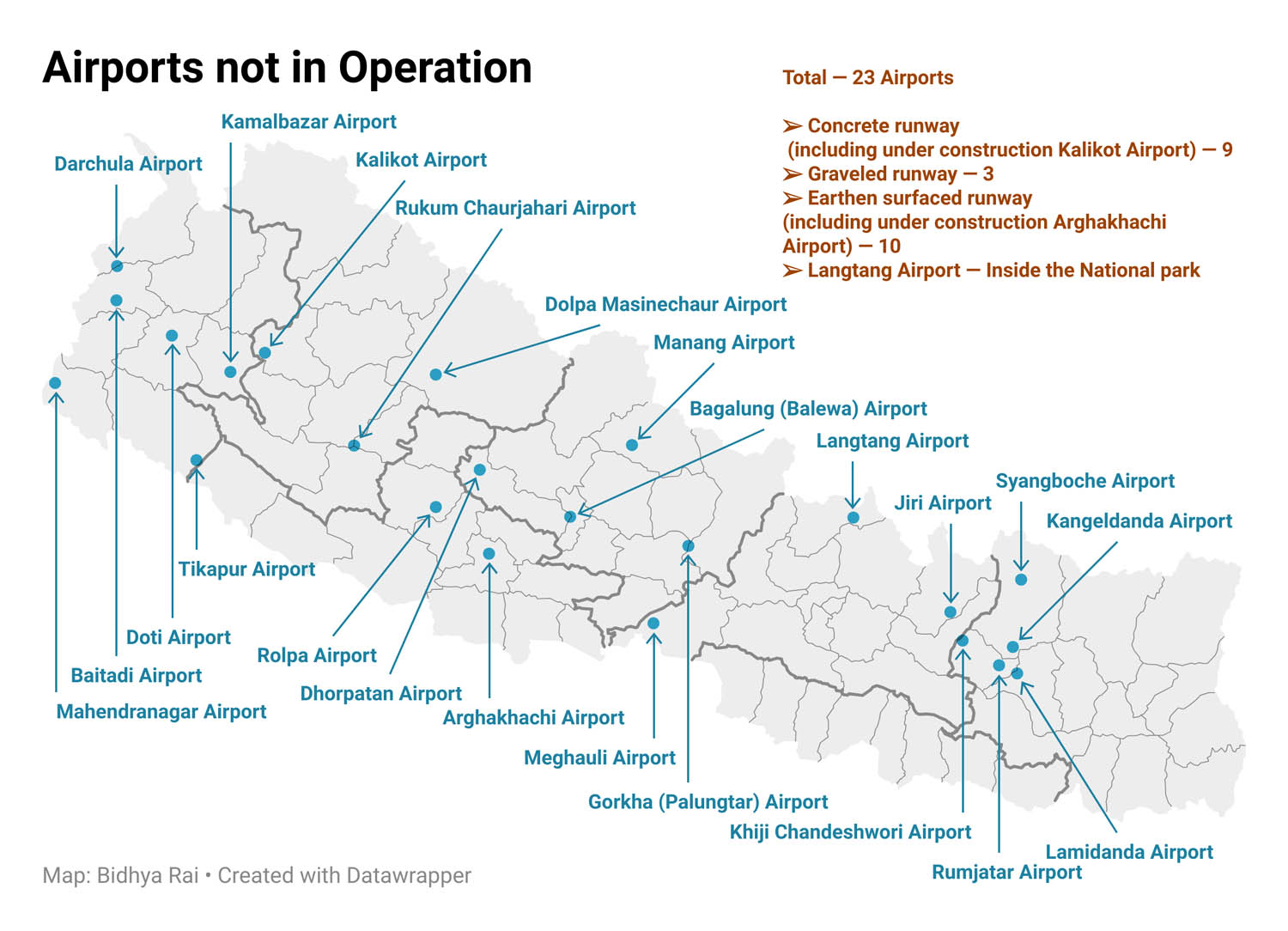National
Nepal’s abandoned airports
Several of them have been built in breach of the Civil Aviation Policy 2006. While the Civil Aviation Authority lists 18 of 52 domestic airports as out of operation, 23 remain defunct.
Basant Pratap Singh & Bidhya Rai
In a televised interview a few weeks ago, Dharan’s mayor Harka Sampang made a rather outlandish comparison between airports and toilets. When asked to explain the need for an airport in Dharan when there is already one in Biratnagar, about an hour by road, he said it’s akin to asking why he should build a toilet in his house when his neighbour already has one. “Should I always use my neighbour’s toilet then?” he questioned.
“We shall build airports” is perhaps one of the most (mis)used campaign promises made by people’s representatives and politicians in Nepal. Sampang’s statement is then not surprising and is indicative of what a majority of people’s representatives in Nepal think about airport construction, even when there is no apparent need for one.
“One can cover the distance between Dharan and Biratnagar on a motorcycle or a car in an hour,” said Ramesh Thapa, a Dharan-based businessman. “Why do we need an airport in Dharan then?”
In November last year, Tourism Minister Sudan Kirati ordered the Civil Aviation Authority of Nepal (CAAN) to undertake a preliminary study of the airport project in Dharan. The distance between Dharan and Biratnagar is less than 40 km and the two cities are connected by a six-lane road.
But this is not the first time local leaders have insisted on the construction of an airport in Dharan. In 2003, then mayor of Dharan, Manoj Kumar Menyangbo, took the lead for land management for the proposed airport. Multiple tourism and civil aviation ministers after that—Lokendra Bista Magar in 2011, Bhim Prasad Acharya in 2013, Kripasur Sherpa in 2015, and Jeevan Bahadur Shahi in 2016—made on-site visits to the proposed airport location in Dandaghopa.
A detailed engineering survey and environmental impact assessment were also conducted for the proposed airport.
The Civil Aviation Policy 2006 says airports are constructed in view of geographical location, population density, regional balance, tourism promotion, proximity with another airport and potential returns.
Generally, the distance between the proposed airport and the nearest airport must be 20 nautical miles (37.04 km) in mountain and hilly regions and at least 40 nautical miles (1 nautical mile=1.852km) in the Tarai and inner Tarai areas.
However, several airports have been built across the country in gross violation of the policy. The list of irregularities carried out in the name of airport construction is long. Selfish motives such as expanding the vote bank and lure of commissions are usually behind such projects which have little “progress” to show after the construction. Several airports that were built at the behest of politicians by transgressing laws and guidelines now lie defunct.
From East to West, there are more than 20 domestic airports in various stages of construction and abandonment.
In Sudurpaschim’s Baitadi district, an airport was constructed in 1994. A plane landed there for the first time in 2020, or 26 years later. The then tourism minister Yogesh Bhattarai was aboard that test flight. After a year of its maiden flight, the airport in Patan was closed. The airport’s runway now serves as a grazing ground for cattle, and a scenic spot for youths to make TikTok videos and locals to take leisurely walks.
“There were around 15-16 flights in the year the airport was operational,” said Kishor Khadka, who is the Sudurpaschim province representative of Summit Air, which conducted flights to the Patan airport. “In the beginning, there were two flights a week. Then, when passengers thinned out, there was one weekly flight. The flight quorum was still insufficient and the flights were discontinued.”
According to CAAN, for the airport’s resumption, the government spent around Rs160 million. In the past three years since the resumption of the airport, the government has spent around Rs1.4 million on operational costs.
As Patan airport lies in wait for flights and passengers all the while incurring heavy operational costs, the neighbouring districts of Darchula and Dadeldhura, a few hours away, await the inauguration of their own airports.
Gokuleshwar Airport on the bank of the Chameliya River in Darchula is only 12.27 nautical miles from Patan Airport in Baitadi. Rs30 million has already been spent on the airport and an additional Rs200 million is needed for its completion.
On 26 December 2021, a meeting of the CAAN chaired by then Minister of Tourism and Civil Aviation Prem Bahadur Ale Magar disbursed Rs1.32 billion for 10 airports in the Sudurpaschim province.
Ale Magar disbursed Rs5 million for the feasibility study of Dadeldhura airport, around nine nautical miles from Patan airport, although the proposed airport goes against section 5.7.1 of the Aviation Policy 2006 which mandates that ‘the distance between the proposed airport and the nearest airport must be generally 20 nautical miles in mountainous and hilly areas’.
The Dipayal airport, in the neighbouring district of Doti, around 17 nautical miles from Dadheldhura, underwent a facelift eight years ago at a cost of around Rs53 million, but was soon stranded because of a lack of passengers. In the past decade, the airport’s operational cost came to Rs8 million.
Of the 10 airports in Sudurpaschim, only Dhangadhi and Bajura airports are in regular operation. Planes reach Bajhang and Sanfebagar in Achham only occasionally. Of the budget disbursed by Ale, Rs30 million was allocated for Sanfebagar which hardly receives any flights and as much for Kamal Bazaar (also in Achham) airport’s facelift.
Ale Magar also disbursed Rs25.1 million for Mahendranagar airport, 26 nautical miles from the Dhangadhi regional airport. The Mahendranagar airport, which was established in 1973, underwent a facelift and was inaugurated again in January 2022.
While politicians underscore the development of the region and ease of life for the locals of rural areas behind their agendas to build airports, the beneficiaries of such projects in Sudurpaschim, which lacks even basic infrastructure, question the given reasons.
“People are dying here for a lack of basic health service. Locals would benefit more from investment in the health sector instead of this mindless spending spree on airports,” said Ganesh Magar, a local from Dadheldhura who promotes tourism in Sudurpaschim and Karnali provinces. “They could invest in upgrading basic tourism infrastructure and roads instead of spending money on airports that no one uses.”
According to CAAN’s website, there are 55 airports in the country, including three international ones. Of the 52 domestic airports, 18 from Darchula in Sudurpaschim to Okhaldhunga in Koshi are currently defunct, the website says. CAAN lists two defunct airports in Baitadi’s Patan and Doti’s Dipayal as currently ‘operational’ and while the airports in Achham and Kalikot are said to be under construction, the runway in the latter is already blacktopped.
In Gorkha of Gandaki province, in Meghauli of Bagmati province and in Mahendranagar of Sudurpaschim province, the airports’ space has been overtaken by private houses and public roads.
In Tikapur in Kailali of Sudurpaschim province, locals have constructed a concrete road through the airport’s runway. Despite a CAAN recommendation that the Tikapur airport can’t be brought into operation given its short runway and settlements around it, the airport still gets a budget of around Rs1.5-2 million a year, according to Yogesh Rawal, a local journalist from Tikapur who is also the chair of the Federation of Nepali Journalists’ Sudurpaschim province committee.
“The airport will certainly not come into operation, but the officials still spend the budget under the pretext of maintaining the runway. They sometimes do some gravel work,” said Rawal.
“There is no fuel storage facility required for an airport to run and given that already a road runs through the airport, it’s not feasible to build an airport here,” said Santosh Khadka, senior vice president of the Tikapur Industry and Commerce Association. “Despite all these facts, they continue gravelling the runway, installing fences and doing paint jobs, spending the budget just for political clout and electoral gains. They prepare the runway as if a plane will land this very afternoon all the while draining the state coffers.”
When the Post sought information about the cost of land acquisition, infrastructure construction, machinery and operational costs of all 23 defunct airports—although CAAN has listed only 18 such airports as defunct—the Authority refused to give information. After intervention from the National Information Commission, the Authority provided the Auditor General’s annual report 2023 to the Post on 11 December 2023. The report established that the 23 airports had incurred a cost of over Rs 1.670 billion in the past decade.
The report also indicates that the feasibility studies for the airports are filled with false statistics and suggests that they are prepared with false data to serve vested interests and for personal monetary gains.
“That airports lie idle for a lack of air transport operation shows that the data on the feasibility study reports are not realistic,” the report states. But Jagannath Niraula, CAAN’s deputy director general and spokesman, says the airports are still being built since they show promise under the plans and policies of the state. “Airports are built to provide service to the local people,” he said.
So why are airports being built by preparing faulty feasibility study reports only to be abandoned later? CAAN officials say these airports will be used during disasters and emergencies, which in turn justifies the cost of building them. However, the Auditor General’s report says that discussing the airports’ alternative use without operating air transport through them would not justify the airports’ construction.
The country’s political leaders, including ministers, lawmakers, local unit representatives and even incumbent and former prime ministers, have openly abused their authority to construct airports to engage in their flights of fancy.

The Falgunanda Sukilumba airport in Ilam which doesn’t see regular flights, was constructed under pressure from then Prime Minister Jhalanath Khanal. As much as Rs250 million has so far been invested in the airport whose construction started in the fiscal year 2010-2011. The Khiji Chandeshwari airport in Okhaldhunga, built at the insistence of Congress leader Bal Bahadur KC at the cost of Rs30 million, is yet to come into operation. The airport was conceived in 2001 when KC was the minister for tourism and civil aviation.
It was completed in 2019 and inaugurated with a test flight from Tara Air’s twin otter. That flight carried the then tourism minister Yogesh Bhattarai and KC himself. There have been no flights to or from the airport since. Similarly, the Resunga Airport in Gulmi built at the behest of CPN-UML’s deputy general secretary Pradeep Gyawali came into operation last year, but has failed to see regular flights. The construction was initiated in 2007.
During the presentation of the annual budget on 29 May 2018, when Yuba Raj Khatiwada was the finance minister, several airport projects were announced. The finance minister had allocated Rs5 million for land acquisition for the airport in Narayanpur in Dang. That same year, the government put forward proposals for new airports in a dozen places including Dharan, Narayanpur, Kavre, Dhankuta, Solukhumbu, Humla, Panchthar, Pyuthan, Tehrathum, Udayapur, Baglung and Mustang. Preliminary studies for these airports have already been conducted. The budget statements between fiscal years 2013-2014 and 2023-2024 show proposals for airports in 20 locations.
The proposed Sagarmatha airport in Jogidaha, Udayapur is another example of how airport proposals are being used to meet strictly political interests. After an EIA in 2021, as many as 13,687 trees from the local community forest were felled and sold. According to data from the CAAN, it spent Rs24.7 million to start airport construction by clearing the forest.
Foundation stones were laid in three places for a single airport. While the airport has not been built yet, the budget for the current fiscal year says it will be upgraded. According to Division Forest Office Udayapur, the airport was announced in the budget statement in 2013 when Narayan Khadka was the minister for urban development. Congress leader Khadka is now a member of parliament representing Udayapur-1.
At Chuhandanda in Tehrathum’s Atharai, there have been at least four feasibility studies for airport construction, between 1975 to 2018.
The airport in Kalikot’s Kotbada was completed last year, 38 years after its inception, but it is yet to see an aircraft. As much as Rs420 million has already been spent on it. However, the Civil Aviation Authority’s website lists the airport as one under construction.
Due to a lack of adequate flights, the two airports in Bhairahawa and Pokhara are reeling under heavy operating costs. But millions of rupees are also spent in defunct domestic airports in the name of ‘office operation’. Once completed, the airports incur operating costs even if they don’t see flights. For instance, after its completion three years ago, the Rumjatar airport has incurred an operating cost of Rs2.051 million. In the past decade, as much as Rs95.3 million has been spent in operating costs for 10 domestic airports in Baglung’s Balewa, Baitadi, Doti, Manang, Mahendranagar, Meghauli in Chitwan, Chaurjahari in Rukum, Rumjatar, Lamidanda and Kangeldanda.
“State coffers are being emptied in the name of air infrastructure to meet populist agendas,” said Govinda Raj Pokharel, a former deputy chair of the National Planning Commission. “Leaders’ announcements of airport construction please people as they assume that would bring about development. But these airports that cannot even raise their own operating costs are a scam.”
Airports that were built in places that had no access to road transport have shut down once they were connected to road networks. The Jiri airport in Dolakha has been a pasture land since Jiri was connected with roads. Jiri, which is known as the gateway to Everest, was connected to the road network in 1986. Since then few passengers have been willing to pay heavy amounts for air transport from the airport.
But since 1996, politicians have been lobbying to reopen the airport. When Dolakha’s Ananda Prasad Pokharel was the minister for tourism and civil aviation in 2015, a detailed project report was prepared once again and Tara Air conducted a test flight. But there were no regular flights. Then in 2018, civil aviation minister Rabindra Adhikari reached the airport and declared it would be operated again even if only for ‘mountain flights’.
Another airport built disregarding aviation policy is Okhaldhunga’s Khiji Chandeshwar Airport. This airport has four other airports within a distance of 20 nautical miles—Rumjatar Airport at a distance of 15.75 nautical miles, Kageldanda Airport at 18.20 nautical miles, Phaplu Airport at 15.75 nautical miles, and Ramechhap Airport at 13.78 nautical miles.
Former tourism minister Yogesh Bhattarai says that airports were essential in the past for areas without access to the road network. “These days, rather than wait for uncertain flights, people use road transport, which is cheaper as well,” he said.
Bhattarai, who claims that not a single airport construction was authorised during his time as a minister, says needless airports just increase the financial burden on the state. Former director general of the Civil Aviation Authority Rajan Pokharel admits many airports are being built under political pressure.
“Once the government allocates budget and orders airport construction, the authority can’t deny it,” he said, adding that the majority of airports have been unable to raise infrastructure costs. The income of Tribhuvan International Airport has been used to fund the operating costs of many airports. As the auditor general’s report says, “The tendency of the Civil Aviation Authority to abandon old airports and commit to the construction of new ones has rendered the state’s investment unproductive.”
(This story has been published in collaboration with the Centre for Investigative Journalism-Nepal)




 6.31°C Kathmandu
6.31°C Kathmandu









%20(1).jpg&w=300&height=200)





